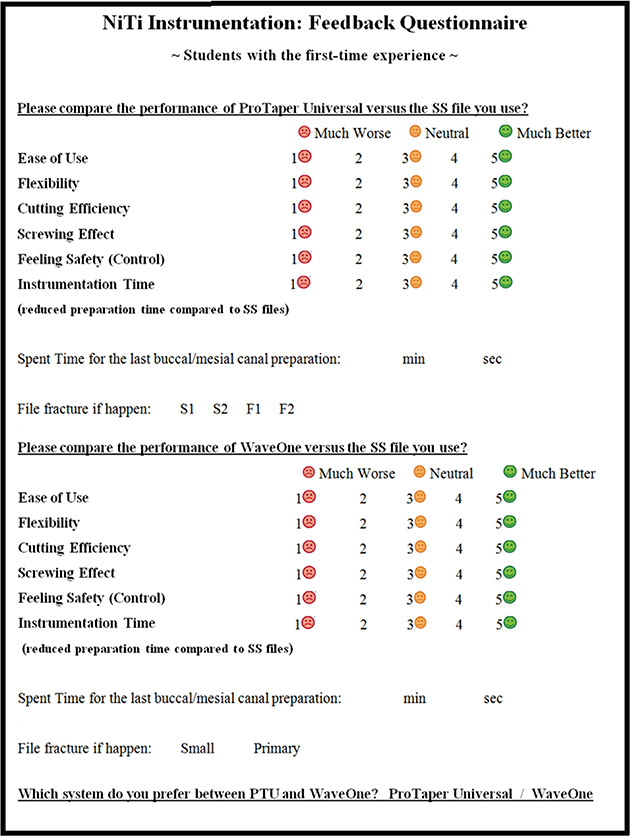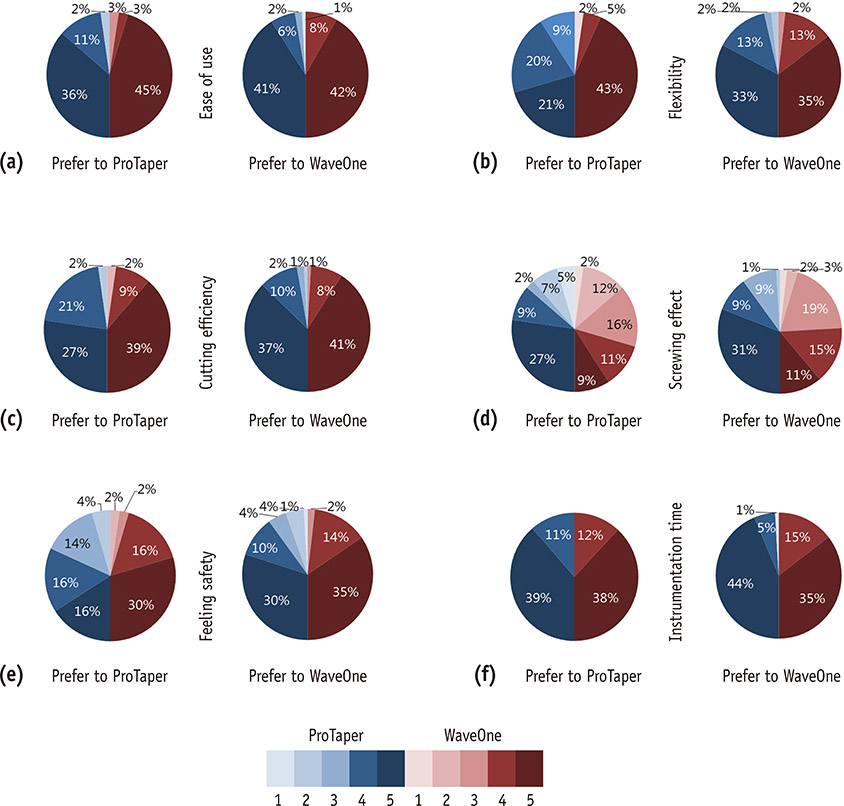Restor Dent Endod.
2016 Aug;41(3):176-181. 10.5395/rde.2016.41.3.176.
Preference of undergraduate students after first experience on nickel-titanium endodontic instruments
- Affiliations
-
- 1Department of Conservative Dentistry, School of Dentistry, Pusan National University, Dental Research Institute, Yangsan, Korea. golddent@pusan.ac.kr
- 2Area of Endodontics, Faculty of Dentistry, the University of Hong Kong, Hong Kong SAR, China.
- 3Department of Conservative Dentistry, School of Dentistry, Kyungpook National University, Daegu, Korea.
- 4Climate Research Department, APEC Climate Center, Busan, Korea.
- KMID: 2346765
- DOI: http://doi.org/10.5395/rde.2016.41.3.176
Abstract
OBJECTIVES
This study aimed to compare two nickel-titanium systems (rotary vs. reciprocating) for their acceptance by undergraduate students who experienced nickel-titanium (NiTi) instruments for the first time.
MATERIALS AND METHODS
Eighty-one sophomore dental students were first taught on manual root canal preparation with stainless-steel files. After that, they were instructed on the use of ProTaper Universal system (PTU, Dentsply Maillefer), then the WaveOne (WO, Dentsply Maillefer). They practiced with each system on 2 extracted molars, before using those files to shape the buccal or mesial canals of additional first molars. A questionnaire was completed after using each file system, seeking students' perception about 'Ease of use', 'Flexibility', 'Cutting-efficiency', 'Screwing-effect', 'Feeling-safety', and 'Instrumentation-time' of the NiTi files, relative to stainless-steel instrumentation, on a 5-point Likert-type scale. They were also requested to indicate their preference between the two systems. Data was compared between groups using t-test, and with Chi-square test for correlation of each perception value with the preferred choice (p = 0.05).
RESULTS
Among the 81 students, 55 indicated their preferred file system as WO and 22 as PTU. All scores were greater than 4 (better) for both systems, compared with stainless-steel files, except for 'Screwing-effect' for PTU. The scores for WO in the categories of 'Flexibility', 'Screwing-effect', and 'Feeling-safety' were significantly higher scores than those of PTU. A significant association between the 'Screwing-effect' and students' preference for WO was observed.
CONCLUSIONS
Novice operators preferred nickel-titanium instruments to stainless-steel, and majority of them opted for reciprocating file instead of continuous rotating system.
Figure
Reference
-
1. Siqueira JF Jr, Rôças IN, Alves FR, Silva MG. Bacteria in the apical root canal of teeth with primary apical periodontitis. Oral Surg Oral Med Oral Pathol Oral Radiol Endod. 2009; 107:721–726.
Article2. Sakamoto M, Siqueira JF Jr, Rôças IN, Benno Y. Molecular analysis of the root canal microbiota associated with endodontic treatment failures. Oral Microbiol Immunol. 2008; 23:275–281.
Article3. Walia HM, Brantley WA, Gerstein H. An initial investigation of the bending and torsional properties of Nitinol root canal files. J Endod. 1988; 14:346–351.
Article4. Cheung GS, Liu CS. A retrospective study of endodontic treatment outcome between nickel-titanium rotary and stainless steel hand filing techniques. J Endod. 2009; 35:938–943.
Article5. Schäfer E, Schulz-Bongert U, Tulus G. Comparison of hand stainless steel and nickel titanium rotaryinstrumentation: a clinical study. J Endod. 2004; 30:432–435.6. Setzer FC, Kwon TK, Karabucak B. Comparison of apical transportation between two rotary file systems and two hybrid rotary instrumentation sequences. J Endod. 2010; 36:1226–1229.
Article7. Gergi R, Rjeily JA, Sader J, Naaman A. Comparison of canal transportation and centering ability of twisted files, Pathfile-ProTaper system, and stainless steel hand K-files by using computed tomography. J Endod. 2010; 36:904–907.
Article8. Yared G. Canal preparation using only one Ni-Ti rotary instrument: preliminary observations. Int Endod J. 2008; 41:339–344.
Article9. Ruddle CJ. Canal preparation: single-file shaping technique. Dent Today. 2012; 31:124126–129.10. Park SK, Kim YJ, Shon WJ, You SY, Moon YM, Kim HC, Lee W. Clinical efficiency and reusability of the reciprocating nickel-titanium instruments according to the root canal anatomy. Scanning. 2014; 36:246–251.
Article11. Jin SY, Lee W, Kang MK, Hur B, Kim HC. Single file reciprocating technique using conventional nickel-titanium rotary endodontic files. Scanning. 2013; 35:349–354.
Article12. Martins RC, Seijo MO, Ferreira EF, Paiva SM, Ribeiro Sobrinho AP. Dental students' perceptions about the endodontic treatments performed using NiTi rotary instruments and hand stainless steel files. Braz Dent J. 2012; 23:729–736.
Article13. Arbab-Chirani R, Vulcain JM. Undergraduate teaching and clinical use of rotary nickel-titanium endodontic instruments: a survey of French dental schools. Int Endod J. 2004; 37:320–324.
Article14. Sonntag D, Guntermann A, Kim SK, Stachniss V. Root canal shaping with manual stainless steel files and rotary Ni-Ti files performed by students. Int Endod J. 2003; 36:246–255.
Article15. Peru M, Peru C, Mannocci F, Sherriff M, Buchanan LS, Pitt Ford TR. Hand and nickel-titanium root canal instrumentation performed by dental students: a micro-computed tomographic study. Eur J Dent Educ. 2006; 10:52–59.
Article16. Guelzow A, Stamm O, Martus P, Kielbassa AM. Comparative study of six rotary nickel-titanium systems and hand instrumentation for root canal preparation. Int Endod J. 2005; 38:743–752.
Article17. Schäfer E, Florek H. Efficiency of rotary nickel-titanium K3 instruments compared with stainless steel hand K-Flexofile. part 1. shaping ability in simulated curved canals. Int Endod J. 2003; 36:199–207.
Article18. Hata G, Uemura M, Kato AS, Imura N, Novo NF, Toda T. A comparison of shaping ability using ProFile, GT file, and Flex-R endodontic instruments in simulated canals. J Endod. 2002; 28:316–321.
Article19. Wolcott S, Wolcott J, Ishley D, Kennedy W, Johnson S, Minnich S, Meyers J. Separation incidence of protaper rotary instruments: a large cohort clinical evaluation. J Endod. 2006; 32:1139–1141.
Article20. Generali L, Righi E, Todesca MV, Consolo U. Canal shaping with WaveOne reciprocating files: influence of operator experience on instrument breakage and canal preparation time. Odontology. 2014; 102:217–222.
Article21. Kim HC, Kwak SW, Cheung GS, Ko DH, Chung SM, Lee W. Cyclic fatigue and torsional resistance of two new nickel-titanium instruments used in reciprocation motion: Reciproc versus WaveOne. J Endod. 2012; 38:541–544.
Article22. You SY, Kim HC, Bae KS, Baek SH, Kum KY, Lee W. Shaping ability of reciprocating motion in curved root canals: a comparative study with micro-computed tomography. J Endod. 2011; 37:1296–1300.
Article23. Bonessio N, Pereira ES, Lomiento G, Arias A, Bahia MG, Buono VT, Peters OA. Validated finite element analyses of WaveOne endodontic instruments: a comparison between M-Wire and NiTi alloys. Int Endod J. 2015; 48:441–450.
Article
- Full Text Links
- Actions
-
Cited
- CITED
-
- Close
- Share
- Similar articles
-
- The effect of gutta-percha removal using nickel-titanium rotary instruments
- Influence of taper on the screw-in effect of nickel-titanium rotary files in simulated resin root canal
- A survey of experience-based preference of Nickel-Titanium rotary files and incidence of fracture among general dentists
- Canal preparation with nickel-titanium or stainless steel instruments without the risk of instrument fracture: preliminary observations
- Effects of heat treatment on the load-deflection properties of nickel-titanium wire



